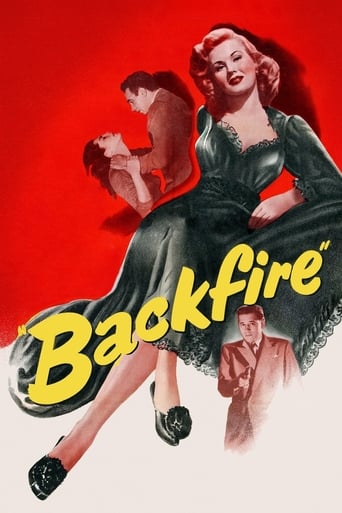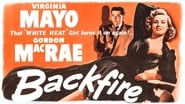jbacks3
I'd like to nominate Backfire as having the most overbearing, obnoxious musical score in the history of motion pictures. Every scene features ominous music to the point of distraction (1947's Angel & the Badman stands on a plateau just below Backfire... but sounds like Wayne & Co. simply recycled a serial soundtrack to save money). Backfire's music undermines every scene, creating the nauseating feeling that every frame is bursting with suspense... essentially validating Ivan Triesault's (as the director Von Ellstein) complaint (paraphrased) in The Bad and the Beautiful (1952) that every scene cannot be climactic. This is a textbook example of how less is more in film noir.
madmonkmcghee
It's hard to resist making puns about the title, but i will. Instead i will use this space to explain why this is not a Noir movie, but a tepid murder mystery. "Pray tell us, oh Wise One!" Right then, are you sitting comfortably? Then i'll begin. Noir stories are all about moral ambiguity and moral choices. People doing the wrong things knowingly but still they can't help themselves. Or they can, but don't. Does this apply to this movie? Only if the O'Brien character had turned out to have betrayed his army buddy, or the cute nurse to have been in cahoots with the killer. Instead we are supposed to be wondering who the killer is, even if it's blindingly obvious as soon as he's on screen. "Excuse me sir, but why exactly are you in this story? You seem to serve no purpose whatsoever. "Ha! How wrong can you be!" And why didn't they make O'Brien the lead? And why, when so many superior noirs are gathering dust, was this put on DVD? Now that's a crime.
evanston_dad
A common cultural theme providing subtext for many a film noir was the alienation felt by servicemen returning from WWII to a world that had adapted itself to their absence. But that theme usually remained just that -- subtext. Rarely was it dealt with as overtly as in "Backfire," a modest entry in the genre from 1950, and this fact alone makes this otherwise forgettable film notable.Bob Corey (Gordon MacRae) and Steve Connolly (Edmond O'Brien) are war buddies, Corey layed up in a veterans' hospital recovering from a spinal injury, Connolly sticking close and providing him moral support. The night before Corey's release, while in a drugged haze, Corey receives a visit from a strange, exotic woman (Viveca Lindfors), telling him that Connolly has been injured himself and is asking for Corey. The next day, as he leaves the hospital, Corey is pulled into the police station, where the head of the homicide bureau (Ed Begley) tells him of the murder of crime boss Solly Blayne and evidence incriminating Connolly as the chief suspect. Corey sets out to find his friend in an attempt to clear his name, aided by his girl Friday, nurse Julie from the veterans' hospital, played fetchingly by Virginia Mayo.What's most interesting about "Backfire" is that though the film gives both men nominal love interests, they're much more interested in each other than either is about anyone else. It would be easy to read homosexual subtext into this film, as it is in many films noir, but it's not really played that way in the movie. The relationship between Corey and Connolly is that of two men who have had to rely on one another in literal life-and-death situations and who now do not know how to rely on anyone else.It was refreshing to see MacRae in a film like this -- I only really knew him from his string of 1950s musicals, and he equips himself well. O'Brien, a frequent presence in films of this sort, is right at home. And Mayo is a doll, looking for all the world like a 1940s version of Laura Linney. The climax of the film is a rote shoot-em-up, but as always with movies like "Backfire," the journey is a lot more fun than the destination.Grade: B
bmacv
The dislocation felt by returning servicemen was one of the chief topical themes of the film noir cycle. After being primed to take risks but no prisoners in the anarchic and violent theaters of World War, many found it hard to ratchet back down upon their return to an often jarringly altered society. Amnesia was the primary noir metaphor -- having to reconstruct an entire past life from scratch. Others faced having to cope with disabilities; still others, having spent the "best years of their lives" in hellholes abroad, weren't about to wait for the high life on the installment plan.Backfire forgoes amnesia for the latter two categories. Gordon MacRae recuperates from spinal-cord injuries in a veterans' hospital until he can get out and buy a ranch with army buddy Edmond O'Brien, who abruptly vanishes. Upon release, MacRae sets out to track him down through the labyrinthine underbelly of postwar Los Angeles. It looks like O'Brien got mixed up with heavy gamblers, and is in fact wanted for apparently murdering a syndicate kingpin. MacRae is aided in his quest by his nurse (Virginia Mayo, good as a good gal for once) but thrown off the trail by a mysterious foreigner (Viveca Lindfors, as a discount-chain Ingrid Bergman). But, as always in the noir scheme, things are rarely what they at first seem....No masterpiece, Backfire nevertheless keeps up the pace and the suspense, drawing (like Somewhere in the Night) on themes and formats that were central concerns of the cycle.




